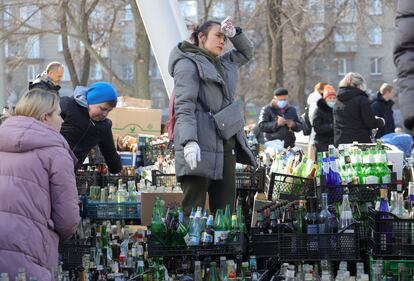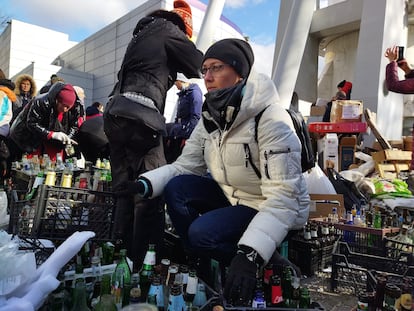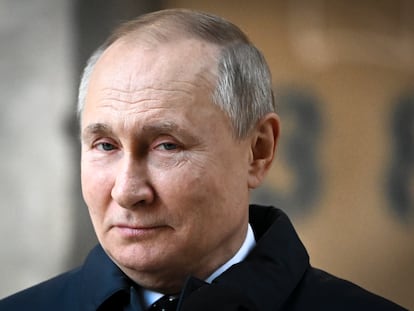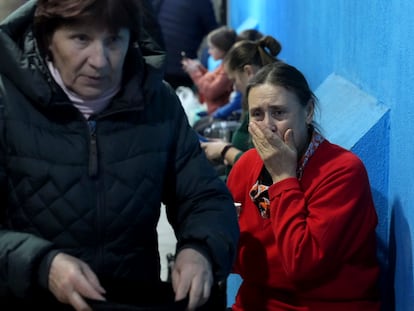From university to Ukraine’s defense force: ‘I have to help protect my country against Russian terrorists’
Thousands of people, from engineers to retirees, are joining the civil resistance against Putin’s troops as Russia intensifies its strikes against major cities


A month ago, Lev Tiskin used to spend his time playing video games online and went out almost every weekend to have a drink with his friends. The 18-year-old had recently started his freshman year in business school at university, and was dreaming about spending the spring break somewhere warm at the beach. Today, the slight young man with gray-blue eyes is carrying a backpack over his shoulder with a few changes of clothes and lining up with dozens of people in a government building in the Ukrainian city of Dnipro. He is waiting to receive instructions – perhaps a weapon too – and will then leave for his assigned destination to defend the city. “I have to help protect my country against Russian terrorists,” he says.
As Russia intensifies its offensive against Ukraine and puts its nuclear deterrence forces on alert, thousands of citizens across the country have rolled up their sleeves and joined territorial defense forces, volunteer battalions and protection groups. They are preparing for total war. The troops sent by Russian President Vladimir Putin – which have invaded from three flanks (north, east and south) and are striking by land, sea and air – have encountered resistance not only from the Ukrainian army, which is trying to contain their advance, but also from civilian groups that, with or without weapons, are trying to protect their cities and towns and repel a force that has double the numbers and the power of Ukraine. In seven days of war, Moscow has not yet taken any major city, although it is escalating its attacks on Kyiv, Kharkiv and Kherson.
In Dnipro, where armed soldiers guard almost all city entrances, volunteers are deploying tank traps and sandbags. Russian troops have not yet reached this city of one million people, which has a Russian-speaking majority and a large Jewish community. But as the missile strikes intensify, the sound of air raid sirens has been ringing in the air.
An alarm goes off near a park, where Tiskin and his friends are waiting. The message is clear: “Run for cover.” Floods of people run to huddle against the walls of a nearby building or curl up to the ground. Recruitment points are key strike targets. Not so long ago, Tiskin said he was “a little scared,” now, he admits he is frightened. “My parents didn’t approve at all. They tried to stop me [signing up as a volunteer fighter], but I came anyway. I have to do something. If not, in a few days there might not be any Ukraine left,” he says.

Olga, dressed in a gray tracksuit with a blue jacket, has just received a firearm. “I have always been a pacifist, but now I must protect my own,” she says. Olga is 33, and has a nine-year-old son. She is an economist and works in an accounting firm. She enlisted when Russia sent tens of thousands of troops to the Ukrainian border, and Ukraine’s Defense Ministry began organizing territorial defense forces. Learning how to apply tourniquets and first aid basics was more for protection than for safety. “I thought it wouldn’t be necessary in the end, but this is no drill,” she says. She is certain that she will apply all her knowledge without hesitation: “It’s a nightmare. Putin is coming for us. And then he will go after Europe.”
Now, Olga is waiting for a car to take her to defend a target she can’t reveal. The territorial defense forces, defined by the Defense Ministry as a tool of “resistance” to deter Russia, are assigned with protecting basic infrastructure such as bridges, roads and tunnels. The economist likes this concept of resistance. She says that everyone she knows is ready to help defend Ukraine. “Putin is an idiot. This has united us even more, if possible. Ukraine will pass this test and come out stronger, with honor,” she says.
Online tutorials to prepare Molotov cocktails
When Putin announced a “special military operation” in the Donbas region to “denazify” Ukraine – an offensive that in fact has evolved into open war in the entire country – Ukrainian President Volodymyr Zelenskiy called on the population to remain calm and resist. After a day of attacks on strategic infrastructure and the siege of key cities such as Kyiv and Kharkiv, Zelenskiy called on civilians to help defend the country in any way possible. For the dozens of people who have gathered in a square in Dnipro, that means making Molotov cocktails. To make the homemade bombs, the group is cutting polystyrene strips and filling up beer bottles with flammable liquid. Meanwhile, other volunteers in the square are packing boxes, organizing supplies and loading the improvised weapon onto cars.
Natalia learned two days ago how to make a Molotov cocktail by following instructions she found online. But today in Ukraine, several media organizations and even radio stations are instructing civilians on how to prepare the bombs. Natalia (who prefers to go by just her first name) says she has not thought – and prefers not to think – about the possibility of having to use them. Doing so would mean that Dnipro is under siege by Russian troops. According to the Ukrainian government, Russian combatants have infiltrated cities throughout the country and are ready to act at any moment. “I contribute more by doing organizational tasks,” says the 37-year-old engineer. “But I’m prepared to fight for my life. And if that means throwing a bomb at a tank or someone, I’ll do it.”

In 2014, when Russia invaded and subsequently annexed Crimea with an illegal referendum and the war in the Donbas region broke out against Moscow-backed pro-Russian separatists, Kyiv was already using volunteer battalions to help shore up its disorganized and ill-equipped army. Back then, these paramilitary groups – some of which had clear links to right-wing extremism and neo-Nazi ideology – came to fight in the east.
The situation is different now. Most of these paramilitary groups were turned into a unit within the Ukrainian army. The mobilization that is now being seen in Dnipro and most Ukrainian cities looks more like civil resistance, with volunteers bringing food to soldiers, donating blood for the wounded, setting up barricades, maintaining the curfew, organizing cyber-surveillance groups and joining the territorial defense forces.
There are no spots left in the defense battalion that Alexander Klasko has joined. All the positions have been filled and now are turning people away, says the 57-year-old driver. A veteran of the Afghan war, he fought in Kabul and Kandahar in 1982. With a firearm over his shoulder, he explains that he enlisted just after Putin launched the invasion because he thought his military experience could be useful. “What can I say, war is war, but this is our home and we can’t let anyone in without our permission.”
Tu suscripción se está usando en otro dispositivo
¿Quieres añadir otro usuario a tu suscripción?
Si continúas leyendo en este dispositivo, no se podrá leer en el otro.
FlechaTu suscripción se está usando en otro dispositivo y solo puedes acceder a EL PAÍS desde un dispositivo a la vez.
Si quieres compartir tu cuenta, cambia tu suscripción a la modalidad Premium, así podrás añadir otro usuario. Cada uno accederá con su propia cuenta de email, lo que os permitirá personalizar vuestra experiencia en EL PAÍS.
¿Tienes una suscripción de empresa? Accede aquí para contratar más cuentas.
En el caso de no saber quién está usando tu cuenta, te recomendamos cambiar tu contraseña aquí.
Si decides continuar compartiendo tu cuenta, este mensaje se mostrará en tu dispositivo y en el de la otra persona que está usando tu cuenta de forma indefinida, afectando a tu experiencia de lectura. Puedes consultar aquí los términos y condiciones de la suscripción digital.
More information
Últimas noticias
Most viewed
- Oona Chaplin: ‘I told James Cameron that I was living in a treehouse and starting a permaculture project with a friend’
- Sinaloa Cartel war is taking its toll on Los Chapitos
- Reinhard Genzel, Nobel laureate in physics: ‘One-minute videos will never give you the truth’
- Why the price of coffee has skyrocketed: from Brazilian plantations to specialty coffee houses
- Silver prices are going crazy: This is what’s fueling the rally










































